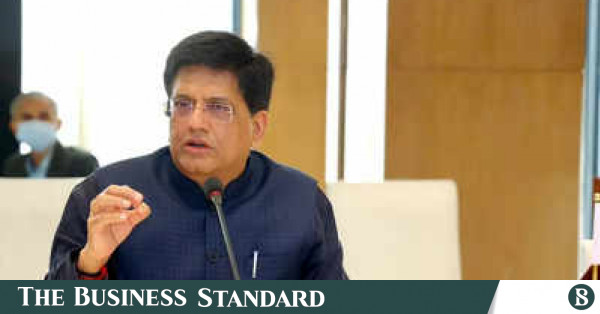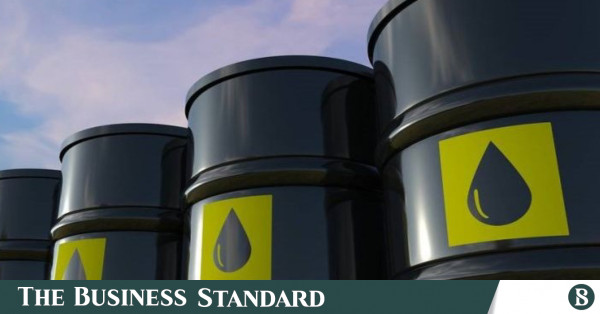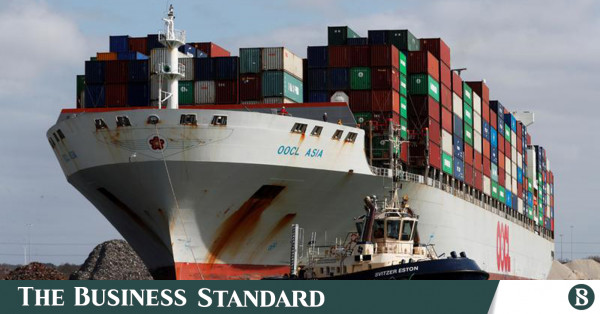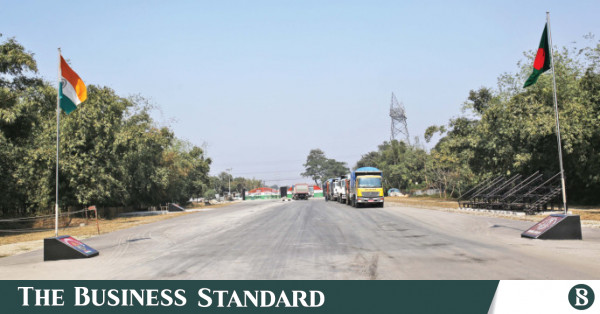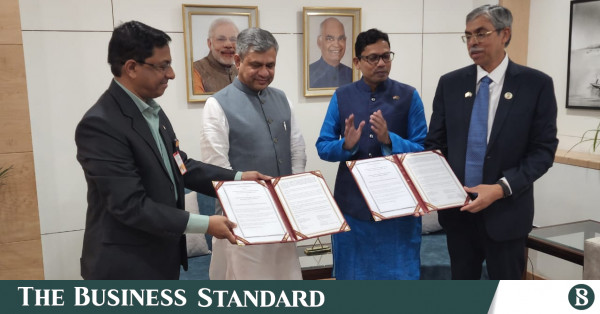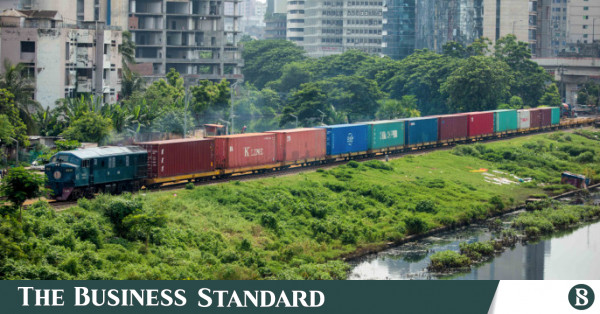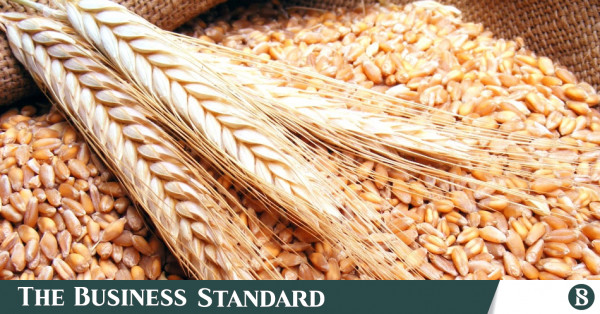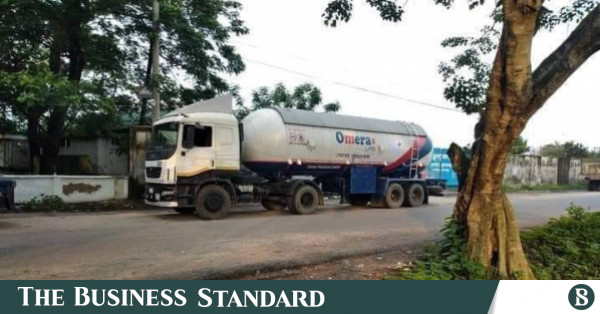Bangladesh and India have agreed to conduct a joint study on the Comprehensive Economic Partnership Agreement (CEPA) at a commerce secretary-level talk on Friday, according to an official statement.
The Indian delegation led by commerce secretary BVR Subrahmanyam and the Bangladesh delegation under senior secretary Tapan Kanti Ghosh appreciated stronger bilateral ties between the two countries.
They noted significant growth in the bilateral trade between the two countries in recent years, the statement said.
On Friday, the two sides also discussed other issues of mutual interest, including development of railway and port infrastructure, border haats (markets), regional connectivity through multimodal transportation and harmonization of standards, the commerce ministry statement said on Saturday.
The two countries have been making endeavours to deepen trade ties after Prime Minister Narendra Modi's Bangladesh visit in March last year, and they are eager to negotiate a CEPA for mutual benefit, one official said, requesting anonymity. Modi had paid a state visit to Bangladesh in March 2021 and agreed to enhance bilateral trade.
Bangladesh is India's biggest trade partner in South Asia, according to the Indian foreign ministry. "Bilateral trade between India and Bangladesh has grown steadily over the last decade and the exports of Bangladesh have tripled over the last decade to cross $1 billion in 2018-19," a note prepared by the ministry said. "In the FY 2019-20, India's exports to Bangladesh were $8.2 billion and imports were $1.26 billion."
To facilitate trade between India and Bangladesh through railways, the two partners on Friday agreed to develop a container handling facility at Sirajganj Bazar, the commerce ministry statement said. For running freight trains between India and Bangladesh, a 900m new siding line is being constructed at Benapole, it added.
The two nations have approved a detailed project proposal (DPP) for the development of rail and road-based inland container depot at Ishwardi and plan to open border markets that were closed due to Covid restrictions, it said.
To boost trade, the two partners have agreed to launch the first meeting of the CEO forum soon, it said.
Bangladesh, which has a key place in India's Neighbourhood First policy, had invited Modi last year for celebrations marking three key events – the birth centenary of Sheikh Mujibur Rahman, 50 years of diplomatic ties, and 50 years of Bangladesh's war of liberation.
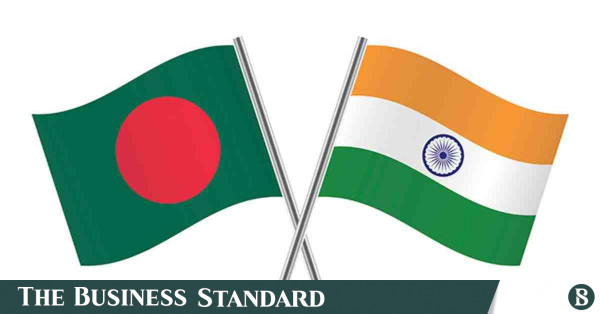
 www.tbsnews.net
www.tbsnews.net
Indian authorities in Guwahati on Sunday received the maiden voyage of food-grains from Patna to Pandu via Bangladesh.
An event was held to welcome the self-propelled vessel MV Lal Bahadur Shastri carrying a total of 200MT of foodgrains for Food Corporation of India (FCI) – completing a maiden pilot in this route.
The Sarbananda Sonowal, India's union minister of ports, shipping and waterways, accompanied by CM of Assam, Himanta Biswa Sarma received the maiden voyage of food-grains.
According to Indian media, this initiative has ushered in a new age for inland waterways in Assam as Brahmaputra (NW2) gets connected with Ganga (National Waterway-1) via the Indo-Bangladesh Protocol (IBP) route.
MV Lal Bahadur Shastri sailed some 2,350km from Patna on NW-1 and passed through Bhagalpur, Manihari, Sahibganj, Farakka, Tribeni, Kolkata, Haldia, Hemnagar; Indo Bangladesh Protocol (IBP) route through Khulna, Narayanganj, Sirajganj, Chilmari and NW-2 through Dhubri, and Jogighopa.
Meanwhile, another vessel MV Ram Prasad Bismil with two barges Kalpana Chawla and APJ Abdul Kalam started voyage from Haldia on 17 February, 2022, and is on the way to Pandu.
The vessel is carrying 1,800MT Tata steel and already reached the Bangladesh border at Dhubri.
The ODC (over dimensional cargo, 252MT) of Numaligarh Bio-refinery reached Silghat on 15 February, 2022, from Haldia through IWT via IBP route.
Another ODC (250MT) consignment is also on the way to Silghat.
While addressing the media, Sonowal said, "Today marks the beginning of a new age of inland water transport in Assam. This is going to provide the business community with a viable, economic and ecological alternative.
"The seamless cargo transportation is a journey of unfulfilled desires and aspirations of the people of Assam. The Northeast region is ready to unlock the value of the Astalakshmi."
Meanwhile, Assam CM Sarma said, "The start of cargo movement through ships through Indo Bangladesh Protocol Route marks the beginning of a new age of economic prosperity for the Northeast region."
This effort to rejuvenate the historical trade routes via Bangladesh got a big push under Prime Minister Narendra Modi's PM Gati Shakti initiative and is expected to ramp up swift movement of cargo over Brahmaputra.
The IWAI is also planning to run a regular scheduled service on these routes.
As per Indian media, to improve the navigability, two stretches of IBP routes, i.e., Sirajganj-Daikhowa and Ashuganj-Zakiganj are also being developed at a cost of Rs305.84 crores on an 80:20 share basis (80% being borne by India and 20% by Bangladesh).
The contracts for dredging on the two stretches for providing and maintaining requisite depth for a period of seven years (from 2019 to 2026) are underway which will further reduce nearly 1,000km.
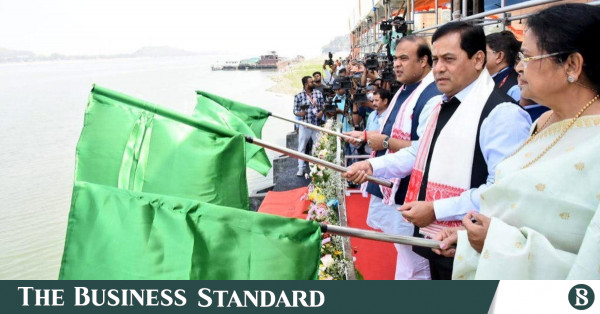
 www.tbsnews.net
www.tbsnews.net
The Indian government has taken an initiative to upgrade its National Highway (NH) 112 – also known as Jashore Road and connecting Kolkata to Bangladesh – into a two-lane highway with state-of-the-art infrastructure.
The road, that links West Bengal's Barasat to the Petrapole border (Bangladesh-India border), is likely to be redeveloped by the end of 2023, India's Minister of Road Transport and Highways Nitin Gadkari recently said.
He had said that development works for this highway would begin by the middle of this year and would be completed by the end of 2023, reports newspaper The Sunday Guardian.
The development came after a letter from Shantanu Thakur, a lawmaker from the neighbouring country's Bongaon, was sent to Nitin Gadkari in September, 2021.
In that letter, Thakur urged Gadkari to look into the development of this highway as it caters to the important transport link between Bangladesh and India.
Shantanu Thakur while talking to The Sunday Guardian said that he is happy that the minister has considered his proposal for the development of this important highway and that he is assured that this long pending task will now be completed.
"I am extremely happy that the minister has given his due consideration to the letter I personally met and submitted to him.
"Once this road gets developed, the adjoining towns in this area would also benefit from it and the people of Bongaon Lok Sabha will immensely benefit from this project," Thakur said.
The 70km highway serves as the most important road between Bangladesh and India, as the Petrapole border is one of the largest land ports in Asia and witnesses a daily business of over Tk113 crore with a yearly movement of about 100,000 trucks between Bangladesh and Kolkata.
Besides, the Petrapole border provides livelihood to thousands of families residing in the townships on this highway and a yearly trade of more than Tk28,000 crore.
According to The Sunday Guardian report, the single-lane highway remains often overcrowded with trucks which leads to severe traffic congestions regularly and moreover the travelling time between Barasat and Petrapole border (70km) is often more than 3-4 hours due to the poor road conditions and overcrowding.
Meanwhile, the demand to widen the highway has been going on for quite a long and the state government tried to take up this issue in 2018 but the project had to be stopped due following protests by environmentalists.
The Jashore Road is dotted with huge trees on both sides, some as old as 100 years and environmentalists objected to the felling of these trees for development purposes.
The case had moved to the Calcutta High Court which allowed the felling of these trees, but this order was later challenged at the Indian Supreme Court by the Association for Protection of Democratic Rights, an NGO.
However, the Ministry of Environment had brought out a notification that to widen or redevelop roads that are less than 100km in length, environmental impact assessment is not required.

 www.tbsnews.net
www.tbsnews.net
The Indian delegation led by commerce secretary BVR Subrahmanyam and the Bangladesh delegation under senior secretary Tapan Kanti Ghosh appreciated stronger bilateral ties between the two countries.
They noted significant growth in the bilateral trade between the two countries in recent years, the statement said.
On Friday, the two sides also discussed other issues of mutual interest, including development of railway and port infrastructure, border haats (markets), regional connectivity through multimodal transportation and harmonization of standards, the commerce ministry statement said on Saturday.
The two countries have been making endeavours to deepen trade ties after Prime Minister Narendra Modi's Bangladesh visit in March last year, and they are eager to negotiate a CEPA for mutual benefit, one official said, requesting anonymity. Modi had paid a state visit to Bangladesh in March 2021 and agreed to enhance bilateral trade.
Bangladesh is India's biggest trade partner in South Asia, according to the Indian foreign ministry. "Bilateral trade between India and Bangladesh has grown steadily over the last decade and the exports of Bangladesh have tripled over the last decade to cross $1 billion in 2018-19," a note prepared by the ministry said. "In the FY 2019-20, India's exports to Bangladesh were $8.2 billion and imports were $1.26 billion."
To facilitate trade between India and Bangladesh through railways, the two partners on Friday agreed to develop a container handling facility at Sirajganj Bazar, the commerce ministry statement said. For running freight trains between India and Bangladesh, a 900m new siding line is being constructed at Benapole, it added.
The two nations have approved a detailed project proposal (DPP) for the development of rail and road-based inland container depot at Ishwardi and plan to open border markets that were closed due to Covid restrictions, it said.
To boost trade, the two partners have agreed to launch the first meeting of the CEO forum soon, it said.
Bangladesh, which has a key place in India's Neighbourhood First policy, had invited Modi last year for celebrations marking three key events – the birth centenary of Sheikh Mujibur Rahman, 50 years of diplomatic ties, and 50 years of Bangladesh's war of liberation.

Bangladesh, India to conduct study on economic partnership pact
The two countries have been making endeavours to deepen trade ties after Prime Minister Narendra Modi’s Bangladesh visit in March last year
Indian authorities in Guwahati on Sunday received the maiden voyage of food-grains from Patna to Pandu via Bangladesh.
An event was held to welcome the self-propelled vessel MV Lal Bahadur Shastri carrying a total of 200MT of foodgrains for Food Corporation of India (FCI) – completing a maiden pilot in this route.
The Sarbananda Sonowal, India's union minister of ports, shipping and waterways, accompanied by CM of Assam, Himanta Biswa Sarma received the maiden voyage of food-grains.
According to Indian media, this initiative has ushered in a new age for inland waterways in Assam as Brahmaputra (NW2) gets connected with Ganga (National Waterway-1) via the Indo-Bangladesh Protocol (IBP) route.
MV Lal Bahadur Shastri sailed some 2,350km from Patna on NW-1 and passed through Bhagalpur, Manihari, Sahibganj, Farakka, Tribeni, Kolkata, Haldia, Hemnagar; Indo Bangladesh Protocol (IBP) route through Khulna, Narayanganj, Sirajganj, Chilmari and NW-2 through Dhubri, and Jogighopa.
Meanwhile, another vessel MV Ram Prasad Bismil with two barges Kalpana Chawla and APJ Abdul Kalam started voyage from Haldia on 17 February, 2022, and is on the way to Pandu.
The vessel is carrying 1,800MT Tata steel and already reached the Bangladesh border at Dhubri.
The ODC (over dimensional cargo, 252MT) of Numaligarh Bio-refinery reached Silghat on 15 February, 2022, from Haldia through IWT via IBP route.
Another ODC (250MT) consignment is also on the way to Silghat.
While addressing the media, Sonowal said, "Today marks the beginning of a new age of inland water transport in Assam. This is going to provide the business community with a viable, economic and ecological alternative.
"The seamless cargo transportation is a journey of unfulfilled desires and aspirations of the people of Assam. The Northeast region is ready to unlock the value of the Astalakshmi."
Meanwhile, Assam CM Sarma said, "The start of cargo movement through ships through Indo Bangladesh Protocol Route marks the beginning of a new age of economic prosperity for the Northeast region."
This effort to rejuvenate the historical trade routes via Bangladesh got a big push under Prime Minister Narendra Modi's PM Gati Shakti initiative and is expected to ramp up swift movement of cargo over Brahmaputra.
The IWAI is also planning to run a regular scheduled service on these routes.
As per Indian media, to improve the navigability, two stretches of IBP routes, i.e., Sirajganj-Daikhowa and Ashuganj-Zakiganj are also being developed at a cost of Rs305.84 crores on an 80:20 share basis (80% being borne by India and 20% by Bangladesh).
The contracts for dredging on the two stretches for providing and maintaining requisite depth for a period of seven years (from 2019 to 2026) are underway which will further reduce nearly 1,000km.

Brahmaputra-Ganga now connected via Indo-Bangladesh route
Maiden cargo from India's Patna reaches Assam via Bangladesh through inland waterways
The Indian government has taken an initiative to upgrade its National Highway (NH) 112 – also known as Jashore Road and connecting Kolkata to Bangladesh – into a two-lane highway with state-of-the-art infrastructure.
The road, that links West Bengal's Barasat to the Petrapole border (Bangladesh-India border), is likely to be redeveloped by the end of 2023, India's Minister of Road Transport and Highways Nitin Gadkari recently said.
He had said that development works for this highway would begin by the middle of this year and would be completed by the end of 2023, reports newspaper The Sunday Guardian.
The development came after a letter from Shantanu Thakur, a lawmaker from the neighbouring country's Bongaon, was sent to Nitin Gadkari in September, 2021.
In that letter, Thakur urged Gadkari to look into the development of this highway as it caters to the important transport link between Bangladesh and India.
Shantanu Thakur while talking to The Sunday Guardian said that he is happy that the minister has considered his proposal for the development of this important highway and that he is assured that this long pending task will now be completed.
"I am extremely happy that the minister has given his due consideration to the letter I personally met and submitted to him.
"Once this road gets developed, the adjoining towns in this area would also benefit from it and the people of Bongaon Lok Sabha will immensely benefit from this project," Thakur said.
The 70km highway serves as the most important road between Bangladesh and India, as the Petrapole border is one of the largest land ports in Asia and witnesses a daily business of over Tk113 crore with a yearly movement of about 100,000 trucks between Bangladesh and Kolkata.
Besides, the Petrapole border provides livelihood to thousands of families residing in the townships on this highway and a yearly trade of more than Tk28,000 crore.
According to The Sunday Guardian report, the single-lane highway remains often overcrowded with trucks which leads to severe traffic congestions regularly and moreover the travelling time between Barasat and Petrapole border (70km) is often more than 3-4 hours due to the poor road conditions and overcrowding.
Meanwhile, the demand to widen the highway has been going on for quite a long and the state government tried to take up this issue in 2018 but the project had to be stopped due following protests by environmentalists.
The Jashore Road is dotted with huge trees on both sides, some as old as 100 years and environmentalists objected to the felling of these trees for development purposes.
The case had moved to the Calcutta High Court which allowed the felling of these trees, but this order was later challenged at the Indian Supreme Court by the Association for Protection of Democratic Rights, an NGO.
However, the Ministry of Environment had brought out a notification that to widen or redevelop roads that are less than 100km in length, environmental impact assessment is not required.

India to upgrade Jashore Road into two-lane, development works to finish by 2023
The Indian government has taken an initiative to upgrade its National Highway (NH) 112 – also known as Jashore Road and connecting Kolkata to Bangladesh – into a two-lane highway with state-of-the-art infrastructure. The road, that links West Bengal's Barasat to the Petrapole border...


